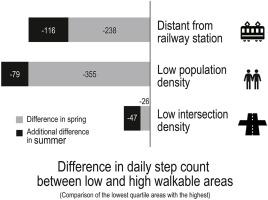Journal of Transport & Health ( IF 3.2 ) Pub Date : 2021-02-18 , DOI: 10.1016/j.jth.2021.101027 Kimihiro Hino , Jung Su Lee , Yasushi Asami

|
Introduction
Walking activity shows differences by season or neighborhood walkability (NW). Elucidation of interactions between season and NW may contribute to the identification of high-risk populations. We examined the interaction effect of objectively measured NW and season on step counts in a large population.
Methods
We analyzed consecutively measured pedometer data collected from 47,233 adults aged 40–79 years who participated in the Yokohama Walking Point Program. Step counts in May 2018 (spring) and August (summer) as well as October (autumn) and January 2019 (winter) were compared. Neighborhoods (postal code areas) were classified into quartiles for each of the three NW variables (i.e., distance to the nearest railway station, population density, and street intersection density). The interaction effect of each of the NW variables and season on step count was examined using mixed-effects linear regression analyses.
Results
The average daily step counts were fewer in summer and winter and higher in areas near the railway stations and areas with higher population density. We found a significant interaction effect of NW and season on step counts in summer. Participants residing in areas farther from the nearest railway station (P < 0.001) or areas with the lowest quartile of population or intersection density (P = 0.001, 0.030, respectively) showed a decline in step counts in summer by up to 118.4 steps/day compared with participants in other areas, which was not found when comparing the step counts between winter and autumn.
Conclusions
NW and season showed interaction effect on adults’ step counts, indicating that in low walkable areas where residents generally walk less, their step counts decrease more in summer when compared with those in other areas; however, this was not the case in winter. Promoting walking in the less walkable neighborhoods, specifically during summer, is required.
中文翻译:

邻里步行和季节对成年人步数的交互作用
介绍
步行活动按季节或邻里步行能力(NW)显示差异。阐明季节和西北之间的相互作用可能有助于识别高危人群。我们检查了客观测量的西北和季节对大量人群中步数的相互作用影响。
方法
我们分析了连续测量的计步器数据,这些数据来自参与横滨步行点计划的40至79岁的47233名成年人。比较了2018年5月(春季)和8月(夏季)以及10月(秋季)和2019年1月(冬季)的步数。对于三个NW变量(即,距最近火车站的距离,人口密度和街道交叉口密度),每个邻域(邮政编码区域)均分为四分位数。使用混合效应线性回归分析检查了每个NW变量和季节对步数的交互作用。
结果
在夏季和冬季,平均每日步数较少,而在火车站附近和人口密度较高的地区则较高。我们发现夏季净重和季节对步数有显着的交互作用。居住在距离最近火车站较远的地区(P <0.001)或人口或交叉路口密度四分位数最低的地区( 分别为P = 0.001,0.030)的参与者显示,夏季步数最多减少118.4步/天与其他地区的参与者相比,在比较冬季和秋季之间的步数时找不到。
结论
西北和季节对成年人的步数显示出交互作用,这表明在步行量通常较低的低步行区,与其他地区相比,夏季步数减少更多。但是,冬天不是这种情况。需要在不宜步行的社区中促进步行,特别是在夏天。











































 京公网安备 11010802027423号
京公网安备 11010802027423号